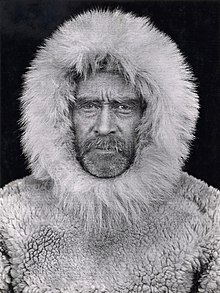Robert Peary | |
|---|---|
 At Cape Sheridan on Ellesmere Island, 1909 | |
| Born | Robert Edwin Peary May 6, 1856 |
| Died | February 20, 1920 (aged 63) |
| Resting place | Arlington National Cemetery |
| Alma mater | Bowdoin College |
| Known for | Claim to have reached the geographic North Pole on his travels with Matthew Henson. |
| Spouse | |
| Children | 4 |
| Awards | |
| Military career | |
| Allegiance | United States of America |
| Branch | |
| Service years | 1881–1911 |
| Rank | Rear admiral |
| Unit | Civil Engineer Corps |
Robert Edwin Peary Sr. (/ˈpɪəri/; May 6, 1856 – February 20, 1920) was an American explorer and officer in the United States Navy who made several expeditions to the Arctic in the late 19th and early 20th centuries. He was long credited as being the discoverer of the geographic North Pole in April 1909, having led the first expedition to have claimed this achievement, although it is now considered unlikely that he actually reached the Pole.
Peary was born in Cresson, Pennsylvania, but, following his father's death at a young age, was raised in Cape Elizabeth, Maine. He attended Bowdoin College, then joined the United States Coast and Geodetic Survey as a draftsman. He enlisted in the navy in 1881 as a civil engineer. In 1885, he was made chief of surveying for the Nicaragua Canal, which was never built. He visited the Arctic for the first time in 1886, making an unsuccessful attempt to cross Greenland by dogsled. In the Peary expedition to Greenland of 1891–1892, he was much better prepared, and by reaching Independence Fjord in what is now known as Peary Land, he proved conclusively that Greenland was an island. He was one of the first Arctic explorers to study Inuit survival techniques.[a] During an expedition in 1894, he was the first Western explorer to reach the Cape York meteorite and its fragments, which were then taken from the native Inuit population who had relied on it for creating tools. During that expedition, Peary deceived six indigenous individuals, including Minik Wallace, into traveling to America with him by promising they would be able to return with tools, weapons and gifts within the year. This promise was unfulfilled and four of the six Inuit died of illnesses within a few months.[1]
On his 1898–1902 expedition, Peary set a new "Farthest North" record by reaching Greenland's northernmost point, Cape Morris Jesup. Peary made two more expeditions to the Arctic, in 1905–1906 and in 1908–1909. During the latter, he claimed to have reached the North Pole. Peary received several learned society awards during his lifetime, and, in 1911, received the Thanks of Congress and was promoted to rear admiral. He served two terms as president of The Explorers Club before retiring in 1911.
Peary's claim to have reached the North Pole was widely debated along with a competing claim made by Frederick Cook, but eventually won widespread acceptance. In 1989, British explorer Wally Herbert concluded Peary did not reach the pole, although he may have come within 60 mi (97 km).[2]
Cite error: There are <ref group=lower-alpha> tags or {{efn}} templates on this page, but the references will not show without a {{reflist|group=lower-alpha}} template or {{notelist}} template (see the help page).